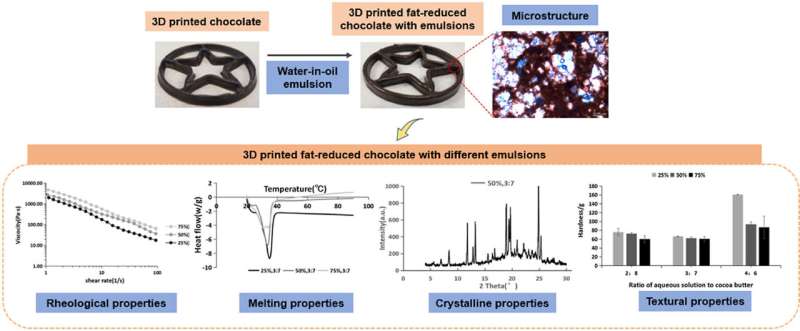Do you want healthy Valentine’s Day chocolates? We can print them

A Rutgers scientist created a low-fat version of chocolate that can printed on a 3D printer. It can be printed in any shape you can think of, even a heart.
The work heralds what the researcher hopes will be a new line of “functional foods”—edibles specially designed with health benefits. The goal is to make healthier chocolates more easily accessible to consumers.
Reporting in the Journal Food Hydrocolloids, a Rutgers-led team of scientists described the successful creation and printing of a mixture producing low-fat chocolate—substituting fatty cocoa butter with a lower-fat, water-in-oil emulsion.
Qingrong Huang, a Rutgers School of Environmental and Biological Sciences professor, said that while everyone loves chocolate, they are also concerned about their health. “To address these concerns, we created a chocolate which is not only low in fat, but can also be printed using a 3D printer. This is our first ‘functional’ chocolate.
Huang, the study’s author, stated that he is already working to reduce sugar content in the new chocolate formula for low-sugar or sugar-free varieties.
Emulsions are created by combining two immiscible liquids to create tiny droplets. In emulsions, the two liquids will usually quickly separate—as is the case with oil and vinegar—unless they are held together by a third, stabilizing ingredient known as an emulsifier. An egg is used as an emulsifier in vinaigrette.
Cocoa butter, cocoa powder, and powdered sugar are the main ingredients in chocolate candy. You can also add any of a number of emulsifiers to make it even more delicious.
The scientific team tried different ratios of ingredients to create a standard chocolate recipe. This was done in order to find the right balance between liquid and solid for 3D printers. To reduce the amount of fat in the mixture, researchers created an water-in-cocoa- butter emulsion that was held together by gum arabic. This extract is commonly used in food industry to replace cocoa butter. The researchers added the golden syrup to the emulsion to enhance its flavor.
Huang stated that chocolate is as delicious to eat as it is to look at.
Researchers used advanced techniques to study the molecular structure of chocolate and its physical properties to determine the physical characteristics. Huang explained that they were trying to find the right viscosity for printing, and also looking for the perfect texture and smoothness “for good mouthfeel”. They experimented with many water-oil ratios before settling on one.
3D printing is the process of creating a physical object using a digital model. This is done by placing layers of material in rapid succession. Huang explained that the 3D printer and the shapes it creates can be programmed using an app on a smartphone.
Ultimately, Huang said he plans to design functional foods containing healthy added ingredients—substances he has spent more than two decades studying, such as extracts from orange peel, tea, red pepper, onion, Rosemary, turmeric, blueberry and ginger—that consumers can print and eat.
Huang stated, “3D food-printing technology allows the development of customized edible goods with tailored taste and shape as well as optimal nutrition based upon consumer needs.”
More information:
Siqi You et al. Development of fat-reduced 3D-printed chocolate by substituting cocoa Butter with water-in-oil emulsions Food Hydrocolloids (2022). DOI: 10.1016/j.foodhyd.2022.108114
Provided by
Rutgers University
Citation:
Are you looking for healthy Valentine’s Day chocolates We can print them (2023 and February 14).
Retrieved 14 February 2023
from https://phys.org/news/2023-02-healthy-valentine-day-chocolates.html
This document is subject of copyright. Except for fair dealings for private study or research purposes, there is no
Without permission, part may not be reproduced. This content is only for informational purposes.